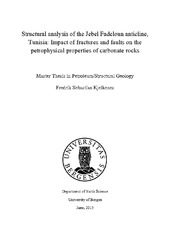| dc.description.abstract | Recognizing the structure, evolution and fluid flow within the earth's crust is a critical issue for both academic and applied geoscience. This study presents structural analysis of an anticline, which aim is to elucidate the (1) structure and evolution of the fold, as well as the associated faults and fractures, (2) to better investigate how tectonics have impacted the microstructural character of the host rock, and (3) to discuss possible implications for petrophysical properties and fluid flow in carbonate reservoir rocks. The topography and geology of northern Tunisia bears a strong imprint of the Atlassic/Alpine collision between Eurasia and Africa, which resulted in the formation of a series of NE-SW trending elongate mountains and basins across the region. A complex tectonic history in Pre- Atlassic times, involving elements of compression, rifting, inversion, strike-slip, vulcanisme and diapirism, also contributes to a complex present-day structural framework. The front of the Tunisian Atlas Mountain Belt ends into a relatively undeformed and stable geological region, known as the Pelagian Province, which comprises the areas of eastern Tunisia, northwestern Libya and extends to offshore Malta and Italy. The study area is located in the boundary between these two geological regions. For the structural and petrophysical characterization of the host rocks and fault rocks in the study area, a variety of methods were used, including i) field mapping and structural cross-sections, ii) outcrop analysis (e.g. fracture density scanlines), iii) thin section analysis, iv) in-situ mechanical strength measurements using a rebound hammer, v) seismic interpretation. This study investigates the structure and evolution of the Jebel Fadeloun anticline, which is located in northeastern Tunisia, near the Gulf of Hammamet. Jebel Fadeloun is a 350 m high hill, formed by a NE-SW trending anticline. The core of the fold uncovers Aptian Limestone. Moving away from the centre, the lithologies, which all pre-date folding, comprise alternating units of limestone and marl, and show youngest formation of Eocene age. Several sets of faults dissect the fold, showing offsets within seismic resolution. Calcite growth and striations in the fault slip planes, indicate dominant normal sense of displacement, occasionally with a component of strike-slip. Fault analyses reveal that fracture frequencies and fault rocks are heterogeneously distributed within the fault zones. Deformed rocks display a variety of microtectonic structures, including brecciation, fracturing, calcite twins and pressure solutions seams. In general, the faulting accounts for enhanced porosities in the carbonate rocks, ranging up to 20 times higher than the host rock porosity. The findings of this study indicates that the Jebel Fadeloun anticline corresponds to a buried structure, formed- and aligned parallel with the Tunisian Atlas structures in Late Miocene-Pliocene. Its proposed origin is contractional ramp-related folding. It is suggested that the faults developed either contemporaneous or subsequent to the folding, and relates to similar stress states. Based on the fault analyses and microscopy analyses it is proposed that the fault zones represent combined conduit-barrier systems for fluid flow. | en_US |
